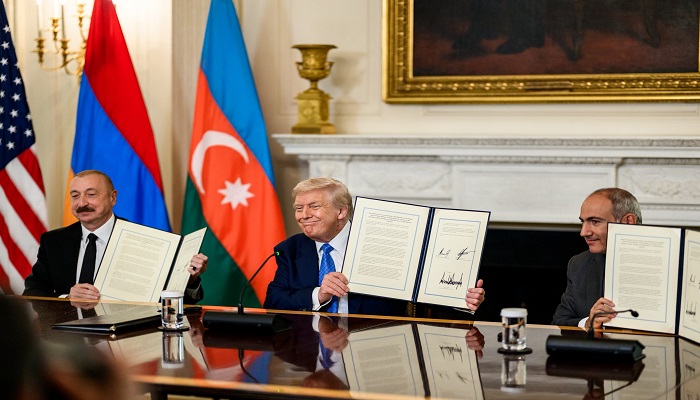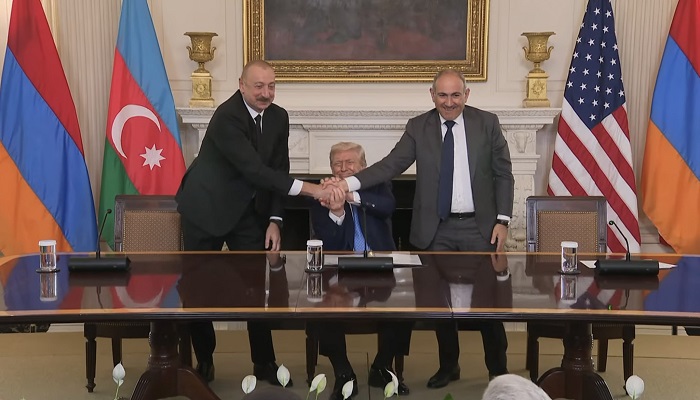Armenia and Azerbaijan signed a peace roadmap on Friday during a high-profile ceremony at the White House, signaling a potential end to one of the most entrenched and violent rivalries in the post-Soviet region.
The accord was unveiled by U.S. President Donald Trump, who hosted both Armenian Prime Minister Nikol Pashinyan and Azerbaijani President Ilham Aliyev in the State Dining Room, hailing the agreement as a milestone for peace, stability, and economic integration in the South Caucasus.
“With this accord, we’ve finally succeeded in making peace,” President Trump declared, flanked by the two leaders.
“Both nations are committing to stop all fighting forever, open up commerce, travel and diplomatic relations, and respect each other’s sovereignty and territorial integrity.”
Armenia and Azerbaijan Edge Closer to Peace with Finalized Draft Deal
The peace roadmap outlines a phased plan for full normalization of bilateral relations, including:
- Permanent cessation of hostilities, reaffirming non-aggression and mutual recognition of borders.
- Restoration of diplomatic ties and the opening of embassies in Baku and Yerevan.
- Unrestricted cross-border trade, travel, and infrastructure development, including joint implementation of transport corridors.
- Establishment of a joint economic commission to promote energy, agriculture, and technology cooperation.
- Creation of a Truth and Reconciliation Panel to address historical grievances, including displacement and casualties from the Nagorno-Karabakh wars.
A significant part of the roadmap involves the Zangezur Corridor, a strategic transit route through southern Armenia’s Syunik region connecting Azerbaijan to its exclave Nakhchivan. The U.S. proposed international supervision and potentially long-term management of this corridor to ensure secure transit.
However, Armenian officials have expressed reservations and rejected proposals that would compromise national sovereignty over the territory, making the corridor’s management a key point of ongoing negotiation.
The agreement marks a diplomatic victory for the United States, especially as Russia’s traditional role as peace mediator has diminished amid its own foreign policy challenges. President Trump emphasized the deal as a win for “American-led diplomacy” and an example of constructive engagement without war.
Political analysts view this shift as a strategic realignment in the region, where U.S. influence is growing, while EU-led and Russian-backed frameworks, such as the OSCE Minsk Group, are now largely sidelined.
“This is the first time we’ve seen real, enforceable commitments by both sides,” said Michael Carpenter, former U.S. Ambassador to the OSCE.
“It could set a precedent for resolving other frozen conflicts in the region.”
In a joint statement, Prime Minister Pashinyan and President Aliyev acknowledged the historical weight of the occasion.
“We look forward to a future where our people can live side by side in peace and prosperity,” said Pashinyan.
Azerbaijan protests to Iran after embassy shooting
“This is not just a political agreement. It is an agreement between generations to end the legacy of war,” Aliyev added.
However, domestic reactions remain mixed, especially in Armenia. While many hailed the potential for peace and economic revival, opposition groups and diaspora communities expressed concern over the Zangezur Corridor, fearing it could undermine national sovereignty or embolden Azerbaijani influence.

Though the roadmap does not restore Armenian control over Nagorno-Karabakh now fully under Azerbaijani administration since the 2020 and 2023 conflicts it includes humanitarian provisions for displaced ethnic Armenians and international monitoring mechanisms for cultural and religious heritage in the region.
The deal avoids thorny issues of war crimes investigations or autonomy status for the Armenian population, leading some rights groups to call it a peace without justice.
Global reactions were largely positive:
- The European Union welcomed the deal as a “long-overdue turning point” and pledged financial support for reconstruction and economic development.
- Russia, once the dominant broker in the conflict, issued a lukewarm statement, noting it “acknowledges the agreement” but also expressing concern over being sidelined.
- Iran, which shares borders with both nations, called for guarantees that regional transport routes will not threaten its own strategic interests.
Azerbaijani long-time foreign minister sacks amid flare-up with Armenia
Implementation of the roadmap is set to begin immediately, with the first direct flights between Yerevan and Baku scheduled for early September. A joint verification team comprising U.S., Armenian, Azerbaijani, and UN observers will oversee the corridor’s establishment and monitor ceasefire compliance.
While many hurdles remain, the White House accord is being hailed as the most significant peace initiative between Armenia and Azerbaijan in more than three decades.



